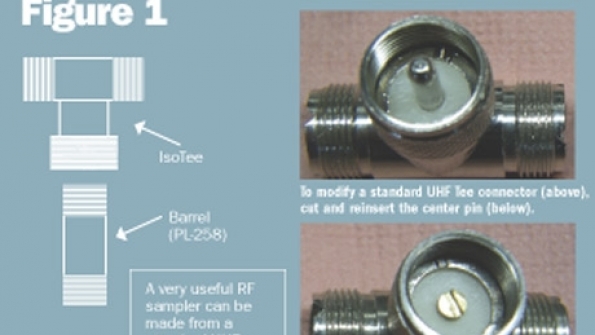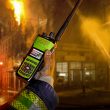Every toolbox needs one of these
Before retirement, I was actively engaged in field service, which often required RF tests and measurement procedures that, in turn, required special equipment, test devices and accessories. The smaller RF test devices and accessories were kept in what I called my “RF Toolbox.” Without a simple — but special — accessory, it might be impossible to run a specific RF test on equipment. Therefore, this special toolbox was always kept close at hand.
One of the most important test accessories to have in your toolbox is the RF sampler. Many years ago I learned how to fabricate a simple RF sampling device from a UHF Tee connector. The idea was to remove the center pin from the connector, using long-nose pliers, and cut the pin to a short length. A hacksaw was used to file a screw slot into the end of the pin so it could be reinserted into the connector using a regular flat-blade screwdriver.
When reinserted into the Tee connector, the end of the pin would be just about flush with the insulator. This homemade RF sampler is usually referred to as an “IsoTee.” Figure 1 shows a modified connector that has been connected to a barrel to create an IsoTee. The photos show a regular Tee connector before modification and one that has been modified. (I don’t know who can truly claim credit for the idea, but that person has my thanks.)
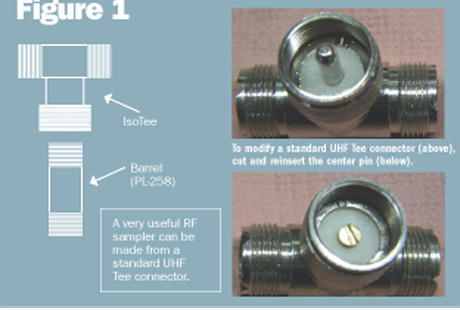
It is a good idea to mark the IsoTee somehow so that you can easily distinguish it from a regular Tee connector, as confusing the two in a test setup could result in disaster. In this regard, I have seen some technicians insert a #8 screw into the end of the barrel to increase the coupling through the arrangement. In any case, be sure that there is no direct or DC contact through the IsoTee. If there is, the purpose is defeated, and equipment damage might result.
Figure 2 shows how the IsoTee is used as a signal sampler to tap into a line running significant RF power. This provides a small sampling of the signal to operate the frequency counter or other sensitive RF instrument. The isolation provided by the IsoTee prevents overloading the frequency counter input, and because of the isolation, there is no noticeable impedance bump on the transmission line.
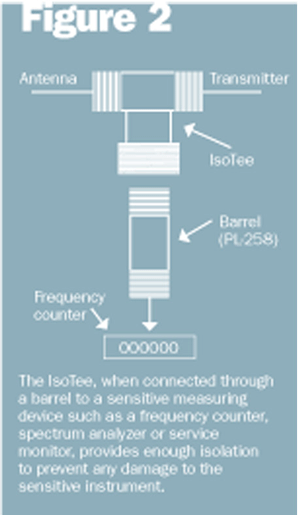
Not only is the IsoTee useful for sampling RF power on a line, but it also is useful for injecting a signal into a line for receiver testing. One of the primary uses for the IsoTee is the effective site sensitivity test, which determines how much degradation the local site noise was causing to the receiver sensitivity. Bench sensitivity means very little in the presence of high site noise.
The basic setup for running this test is shown in Figure 3. First, the 50-ohm termination is connected to the left side of the IsoTee and the signal generator is set to produce 12-dB SINAD at the receiver output. The output level of the signal generator is measured in dBm and recorded. Then, the 50-ohm termination is disconnected and the antenna is connected. The signal generator is adjusted to again produce 12-dB SINAD at the receiver output. The new signal generator level then is recorded.
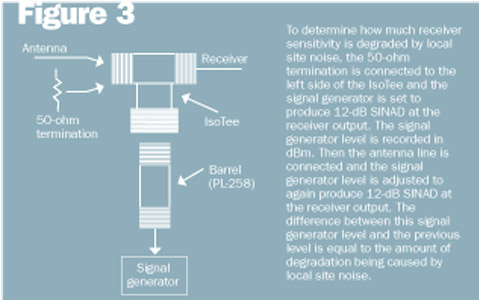
The difference between the required signal generator levels (in decibels) is equal to the amount of noise degradation experienced at the site. Due to the isolation, high signal generator output levels will be required to produce 12-dB SINAD at the receiver output. This simple test setup works quite well because we are not measuring the absolute signal level. We are only concerned with the difference between signal levels, in decibels, when the termination is connected versus when the antenna is connected.
Typically, a signal generator should be terminated into a 50-ohm load. It is standard practice to use something like a 6-dB pad between the signal generator and the receiver. At higher frequencies the barrel and the standard Tee connector can cause an impedance mismatch. For the die-hard purist, the following setup might be used. Figure 4 shows how a pad between the generator and the Tee connector and a 50-ohm termination on the connector can reduce any impedance mismatch problem caused by the IsoTee setup. If the return loss without the pad is 10 dB and a 6-dB pad is used, the return loss with the pad will be 22 dB. A return loss of 10 dB is equal to a standing wave ratio (SWR) of around 1.92:1, and a return loss of 22 dB is about equal to an SWR of 1.17:1.
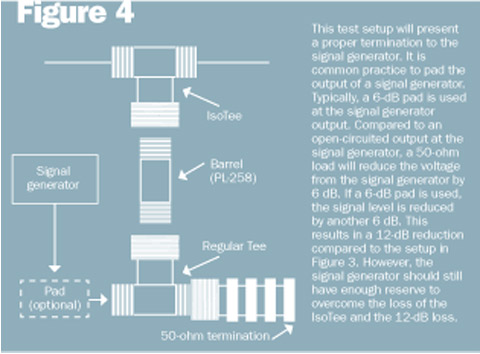
The reason for this dramatic improvement with a pad is that we get a two-for-one improvement in return loss. Because the signal has to travel through the pad in the forward direction and back through the pad in the reverse direction, the signal is attenuated twice. In other words, a 6-dB pad gives us an additional return loss of 12 dB. Good engineering practice calls for the use of pads in many test procedures.
For those who don’t want to construct their own, RF Industries makes a commercially available RF sampler. The RFA4059A sampler can be used with many different types of RF connectors that are available from the company. Connectors supplied with this RF sampler are N-male on one side and N-female on the other side. This sampler can be used with any of the Unidapt connectors available from RF Industries. The company also offers a kit of adapters for the RFA4059A RF sampler that makes it convenient to connect almost anything to anything. The sample port of the RF sampler is through the BNC connector, and the degree of coupling is adjustable.
Bird Electronic Corp. also offers a commercially available RF sampler that can be mounted to the Bird 43 wattmeter. The amount of coupling is adjustable. Signal samplers of various types are available from most of the wattmeter manufacturers. These include directional and non-directional samplers that are built into wattmeter “slugs,” as well as sample ports that are mounted on the wattmeter housing.
RF samplers can be classified as directional or non-directional, adjustable or fixed, frequency-compensated or non-compensated. It is impossible to describe all of them here. Choose the types that are best-suited to your needs and keep them handy in the RF toolbox. Until next time, stay tuned!


